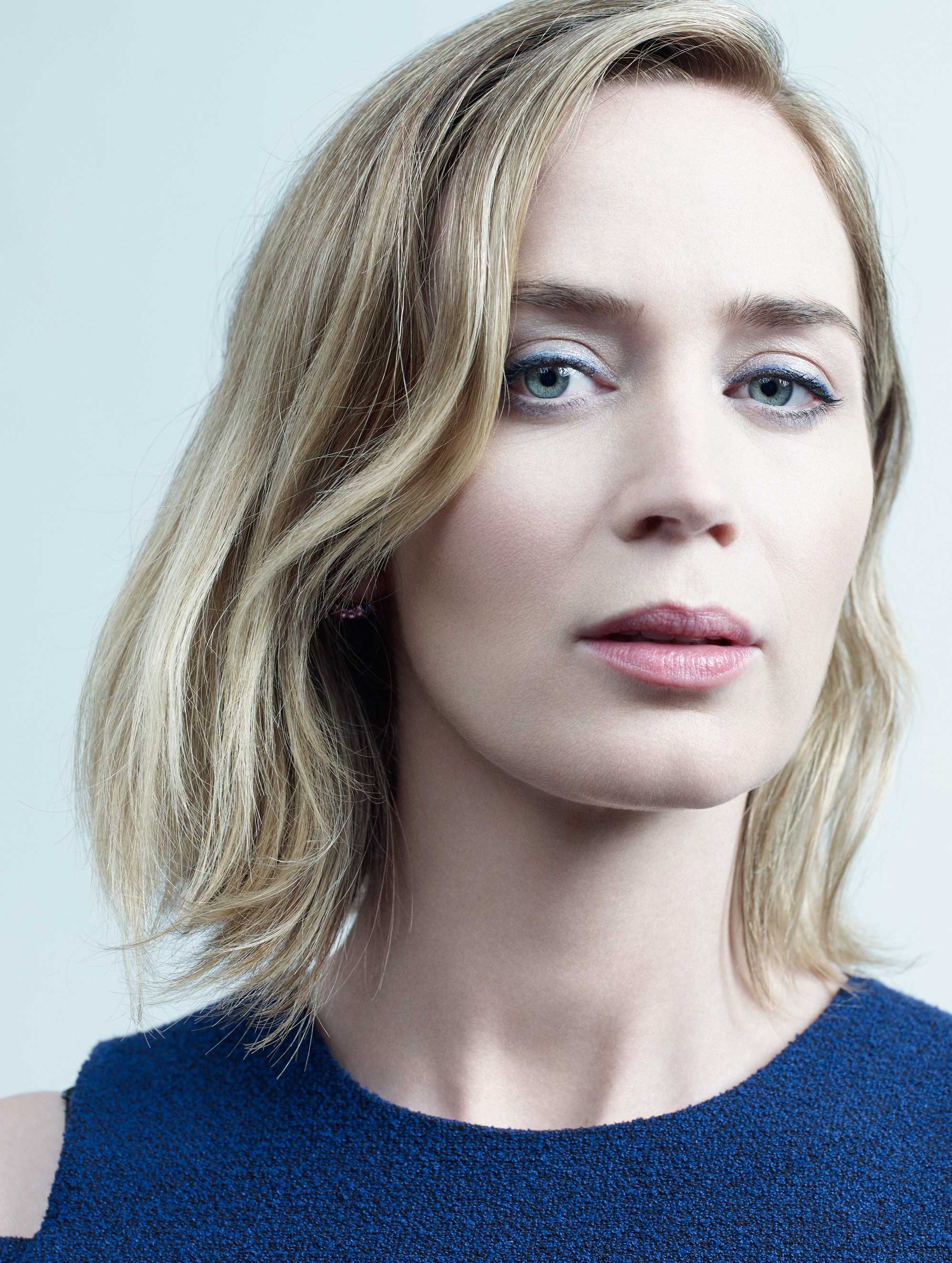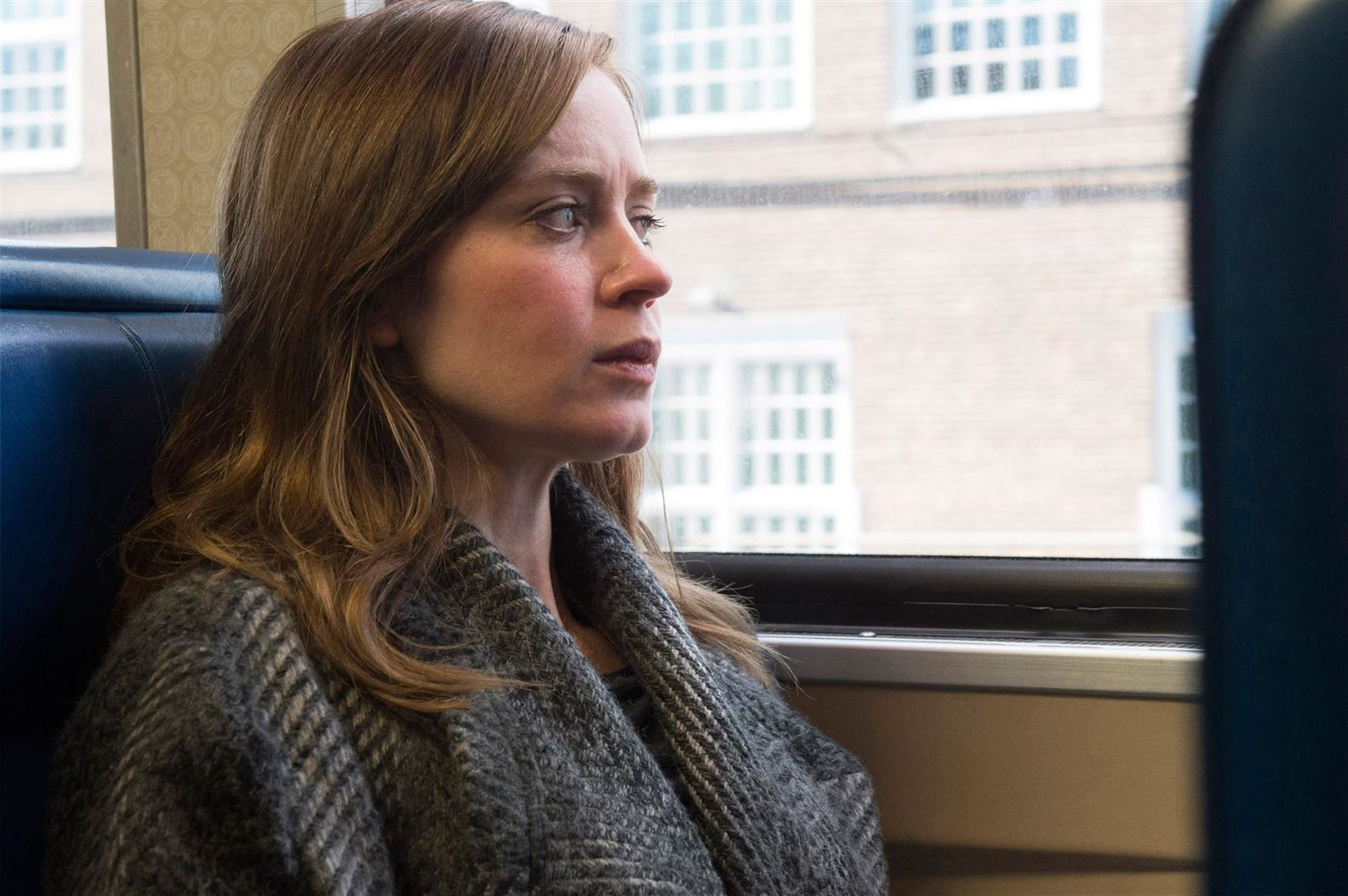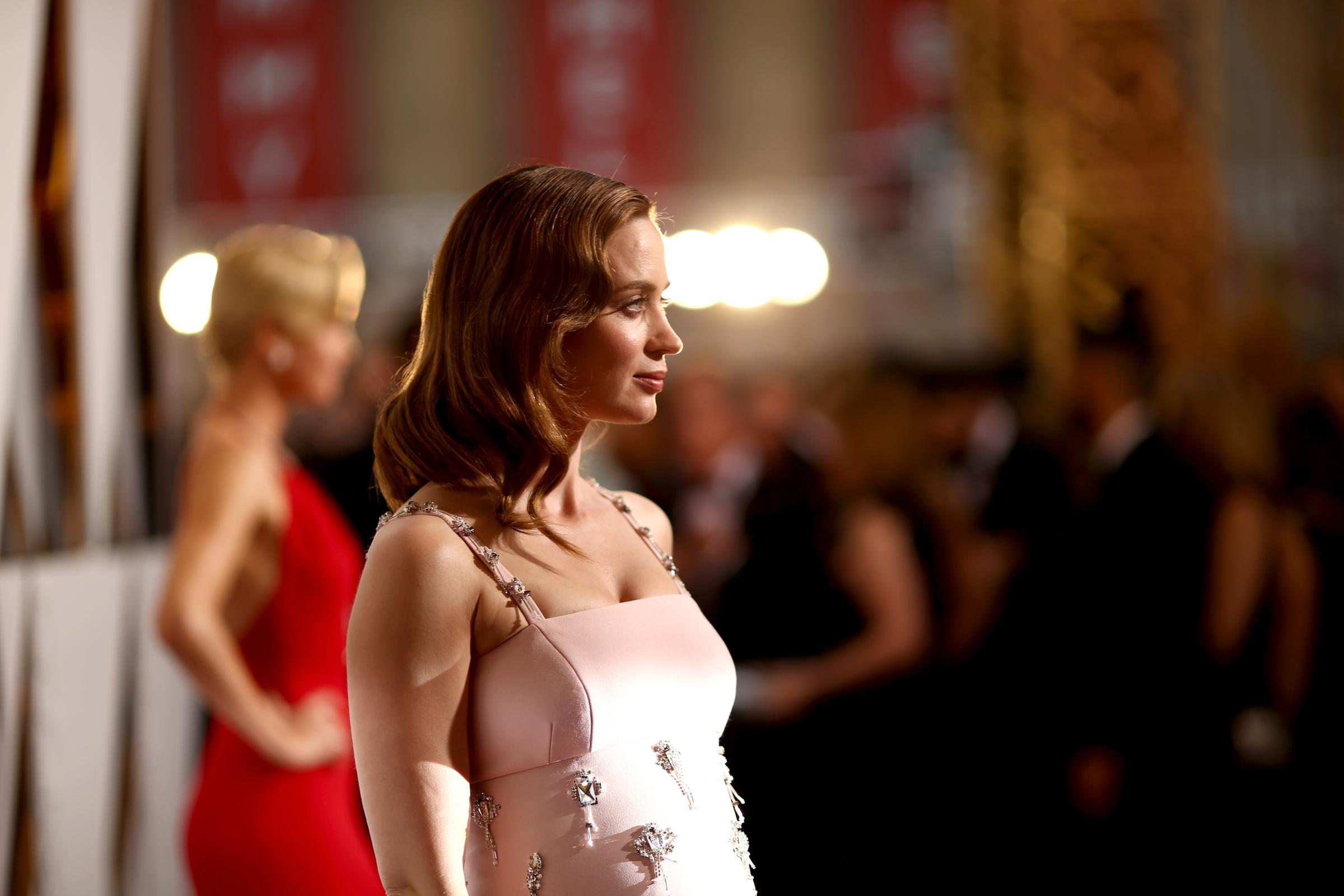
Emily Blunt has come a long way from her star-making turn as a Louboutin-loving fashionista in 2006’s The Devil Wears Prada. To play the lead role in The Girl on the Train, out Oct. 7, she had to deglamorize like never before. “Talk about no makeup,” she says over salmon teriyaki and iced green tea at a Brooklyn sushi joint on a late-summer evening. “We added makeup to make me look even more like I had no makeup.” Each day she was decorated with prosthetic under-eye bags, varicose veins and rosacea, along with a changing array of contact lenses meant to evoke various stages of inebriation: pinkish for buzzed, bloodshot for hammered, tinged with yellow for brutally hung over.
Yet for all the attention on the minutiae of her appearance, the key to playing such a truly damaged character—a divorced, infertile alcoholic obsessed with the perfect-looking lives of a couple she whizzes past on her daily commute—lay far beneath the bleary-eyed surface. To bring Rachel Watson to life, Blunt, 33, had to learn how to identify with the humiliation and isolation familiar to many addicts. She disappeared so thoroughly into the character that even her husband, actor and director John Krasinski, says he didn’t recognize her onscreen. “For the first time ever,” he says, “I forgot it was my wife.”
High praise as that may be, Blunt will need to impress legions of tougher critics: the millions of readers who buoyed the movie’s inspiration, Paula Hawkins’ 2015 novel of the same name, to the No. 1 spot on the New York Times best-seller list for 13 weeks straight. While the book is the kind of impossible-to-put-down Hitchcockian psychodrama that begs for a film adaptation, its success creates a daunting bar for the movie to clear. “That’s what I found so appealing,” says Blunt. “It’s less about the thriller of whodunit. It’s the idea of your blackout drunk protagonist making sure she didn’t do it.”

The novel weaves together the perspectives of three interconnected women. There’s Rachel, who rides the commuter train from suburban Westchester into New York City. (The movie transplants the story from the book’s London setting to the U.S., though Blunt keeps her accent in tribute to Hawkins’ story.) Then there’s Megan (Haley Bennett), whose house Rachel’s train passes each day and who, Rachel imagines, has a perfect marriage. And finally there’s Anna (Rebecca Ferguson), the real estate agent whom Rachel’s husband (Justin Theroux) left her for. When Megan goes missing, Rachel believes she can help solve the mystery— though she can’t be sure that she didn’t, during a blackout, have something to do with Megan’s disappearance.
The challenge for director Tate Taylor, whose credits include the 2011 civil rights-era drama The Help and the 2014 James Brown biopic Get On Up, was to produce an unflinching portrait of addiction without skimping on the pleasures of a thriller. “I was really protective of the addict and her emotions,” he says. “I’ve been touched by it—everybody has at some point. I didn’t want to make a film where it was not treated properly.”
Since breaking out stateside in Prada, the London-born Blunt has shown uncommon range as an FBI agent (Sicario), a singing baker’s wife (Into the Woods) and a bona fide action hero (Edge of Tomorrow). She knew how easily portraiture could slide into caricature. “I was nervous to do that drunk-uncle act,” she says. To avoid the pitfalls (and pratfalls) of exaggeration, she immersed herself in literature on substance abuse, talked to recovering alcoholics and watched lots of the A&E reality series Intervention.
“You see the humiliation of being an addict and what it does to your family,” Blunt says of the show’s depiction of chemical dependency. “And physically, I needed to see how alcoholics move when they’re really wasted.” Those movements had to be calibrated for every scene, so Taylor and Blunt created a system of levels to indicate drunkenness that could work as cues—“kind of like the Homeland Security color codes,” jokes Taylor.
Blunt offers an example of a common mistake people make when trying to impersonate a drunk: the wobbly, all-over-the-place stagger. “That’s not what a drunk looks like,” she says, citing advice from a friend of hers who generously shared his own experiences with alcohol dependence. “A drunk is trying to focus on you. They’re actually trying to get things to come into focus.”
Behind the murky haze in those searching eyes is a throbbing, desperate humiliation. “When you have that foggy recollection of the night before, there’s a shame that comes along with it that she plays so beautifully,” says Theroux. “Living with that shame, it snakes its tail: the more shame you feel, the more you drink. The more you drink, the more shame you feel.”
The physicality required by the part extended beyond drunken confrontations to violent tussles, which were tricky not so much for their choreography as for the fact that Blunt found out she was pregnant a week before filming began. Trying to keep it under wraps proved difficult. After dodging fiery explosions in Edge of Tomorrow, she recalls, her concerns about tweaking a hip while getting up off the floor had Theroux raising an eyebrow. (Theroux, who is a longtime friend offscreen, guessed early on; he was the only one who knew until she reached about 18 weeks. “It required a lot of check-ins between takes,” he says now. “‘Did that hurt? I’m so sorry.’ I was so terrified to touch her in any way that was remotely aggressive.”)
It was also an interesting position for Blunt to find herself in, considering that so much of Rachel’s discontent derives from her inability to get pregnant. But Blunt had plenty of experience observing that struggle among women in her own life. “I’ve seen how you literally can’t put one foot in front of the other without thinking about it every day,” she says. “I’ve seen women feel like they’re not women because they can’t have a baby.”
Few big-budget Hollywood films feature such a compromised female character in a lead role, and Blunt’s self-loathing narrator who can’t even trust her own memory could clang with some viewers. But Taylor says the goal was empathy, not likability. “Do I need to have Rachel have a karaoke moment in a bar where you think she’s adorable?” Taylor says. “When you lean into someone’s pain and get to the root of it, you soften. You want them to win.”
Blunt says she found the role, free of the typical leading woman cliches, liberating. “It was so refreshing that I didn’t have to worry about appealing to a male audience. I don’t give a sh-t, honestly,” she says with a laugh. “All I want is for people to understand her.”

Like the book that inspired it, The Girl on the Train works not only because it’s thrilling but also because it successfully grapples with broader themes. Anxieties about class, fidelity and unmet expectations come to the fore as Rachel tries to solve the mystery. She faces the pain of her disappointments by staring down a bottle of vodka, while the life she craves—a loving marriage in a charming white colonial—recedes from view through the window of a train.
Quiz: We Can Guess Your Major Based on Your Style
Her extreme way of coping may not be universal, but the feelings that drive it are. Social media offers a constant stream of glowing status updates—the more meaningful career, the more affluent lifestyle, the more intimate marriage—that can erode even the most confident among us. Strip away the specifics, and we’ve all been Rachel, staring out at the life we’d rather have. “We live in a world of ‘the grass is greener,’ living vicariously through others,” says Blunt. “But the life you think you want is not necessarily real.”
Back at the sushi restaurant, her salmon teriyaki obliterated, Blunt takes out her phone and pulls up a photo of her 9-week-old daughter, as if to lighten the mood. “Aren’t baby smiles the best?” she asks. With her two kids in mind, she’s lined up a slate of roles that reflect a desire to move away from Train‘s darkness and, in her words, “go toward the light”: her next four projects are an animated film called Animal Crackers, My Little Pony: The Movie, a Gnomeo & Juliet sequel and, most notably, breathing new life into the beloved nanny in Disney’s Mary Poppins Returns, due out in 2018.
Still, you won’t find those baby smiles on her Instagram feed, because Blunt doesn’t have one. She’s content playing characters for a living and says she has no desire to make her daily life into a larger spectacle. “People can make assumptions based on what they see on the red carpet, but that’s not my life,” Blunt says. “There’s nothing real about it.”
Quiz: Are You Ready for Back to School?
When our conversation ends, she’ll go home, feed the baby and tune in to last night’s episode of her favorite guilty pleasure, America’s Got Talent. It’s a kind of antidote to the jealous train-window glare: not envying the lives of others but rejoicing in their success. And then, when the credits roll, perhaps she’ll turn off the TV and rejoice in her own.
More Must-Reads from TIME
- Cybersecurity Experts Are Sounding the Alarm on DOGE
- Meet the 2025 Women of the Year
- The Harsh Truth About Disability Inclusion
- Why Do More Young Adults Have Cancer?
- Colman Domingo Leads With Radical Love
- How to Get Better at Doing Things Alone
- Michelle Zauner Stares Down the Darkness
Write to Eliza Berman at eliza.berman@time.com